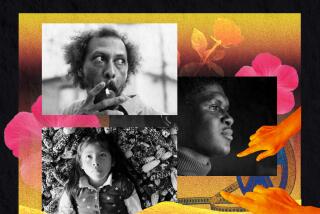TAKE UNDERWATER TRIP AROUND GLOBE
SAN DIEGO — You won’t find any Pee-Wee Herman film footage in the latest edition of the San Diego Underwater Film Festival, although Hollywood’s newest nerd did submit a submarine entry. (It was rejected as too amateurish.)
Instead, audiences attending the 21st annual festival, with shows tonight and Saturday at the Civic Theatre, will see the extravagant underwater scenes that have made this event one of the biggest and most popular of its genre in the world.
While the festival’s slide series are limited to four minutes and the films to less than 30 minutes, the show’s subject matter and geographical range is considerable, including coverage of humpback whales in Hawaiian waters, diving in the clear waters off Belize, the Sulu Sea in the Philippines and accounts of diving in Australia, Florida, the Great Lakes, Baja California, Southern California and the Virgin Islands.
A four-minute slide overview of Southern California’s giant kelp beds entitled “The Amber Forest,” which was made by two local marine biologists, will be shown Saturday. Friday “Muro Ami Dilemma,” a film about a primitive commercial fishing method, which uses free-diving teen-age youths, and its impact on coral reefs in the Philippines will be shown, along with movies about the Red Sea and a special piece on handicapped divers.
Sponsored by the Underwater Photographic Society of San Diego Inc., the show annually attracts 5,000 to 6,000 people. “There are about 160 members in the society,” said spokeswoman Carole Shaw.
“We figure 50% of the audience are divers and the other half are people who are either interested in the sea or a night’s entertainment,” said festival chairman Tom Sullivan, who presided over the selection committees which reviewed and picked this year’s slide series and films. The big draw of course is the display of gorgeous underwater colors ranging from brilliant corals and vivid blue waters to the multicolored marine creatures and diversity of animal and plant life found beneath the seas.
This year’s featured guest and master of ceremonies is Eugenie Clark, an internationally recognized authority on sharks. Formerly director of the Cape Haze Marine Laboratory in Sarasota, Fla. and currently a faculty member at the University of Maryland, Clark was one of the first women to dive extensively. “Lady with the Spear” and “Lady and the Sharks” are books she has written about her experiences as a diver. Rather than sharks, Clark’s primary area of interest will be the Red Sea in her narration of two films, “Life in an Undersea Desert” and “Treasures of Ras Muhammed.”
Another highlight will be underwater cinematographer Bill MacDonald’s film “Freedom in Depth.” It records a technique of teaching the handicapped to dive. MacDonald, who lives in Los Angeles, worked for five years for the Cousteau Society as director of special projects and as a member of the vessel Calypso’s diving and film team. “I was doing a film on the Channel Islands and there was a group of handicapped people out diving. I ended up producing a film on the training program.” The group of handicapped divers he filmed included a blind person, paraplegics and quadriplegics, who used underwater scooters for propulsion. “At first the handicapped were extremely reserved and withdrawn. But by the time they finished they were very robust.” They dived with able-bodied people. For the handicapped, MacDonald said, gravity reduces their mobility on land. Water frees them from gravity.
“The blind can’t see the underwater colors, but the reward is the sense of accomplishment, the thrill and camaraderie, much like anyone else,” MacDonald said. “Someone signed up the blind person as a joke. He went through with it and said it was the greatest thing he ever did.”
Footage shot by local film producer Lenora Carey on the Philippine commercial fishing technique known as muro ami, is scheduled to appear on television in the Sept. 26 segment of “20-20” with Geraldo Rivera. The film, “Muro Ami Dilemma,” shot for Carey by San Diego cinematographer Howard Hall, will be seen at the festival Friday night. It depicts how a primitive commercial fishing technique is destroying the reefs in the Philippine Sea.
In muro ami, a long line with up to 250 rocks dangling from it is dumped into the water and arranged by youths--one above each rock--in a semicircle. The boys, whose average age is 15, jerk the lines, causing the rocks to make a noise as they thump across the reefs, frightening the fish. Meanwhile more youths free dive 80 to 100 feet to the bottom, where they secure a yawning bag net. Holding their breath for periods of up to two minutes on the bottom, they manage the net while the advancing ring of thumping rocks herds the fish into it.
Between this method, which destroys the coral with the steady hammering of the rocks, and illegal dynamiting, the ecology systems of the reefs are being wiped out, Carey said. “The irony is that these poor people need the fish to subsist.”
The film festival begins at 8 p.m. each night. Tickets are $8.
More to Read
Only good movies
Get the Indie Focus newsletter, Mark Olsen's weekly guide to the world of cinema.
You may occasionally receive promotional content from the Los Angeles Times.










